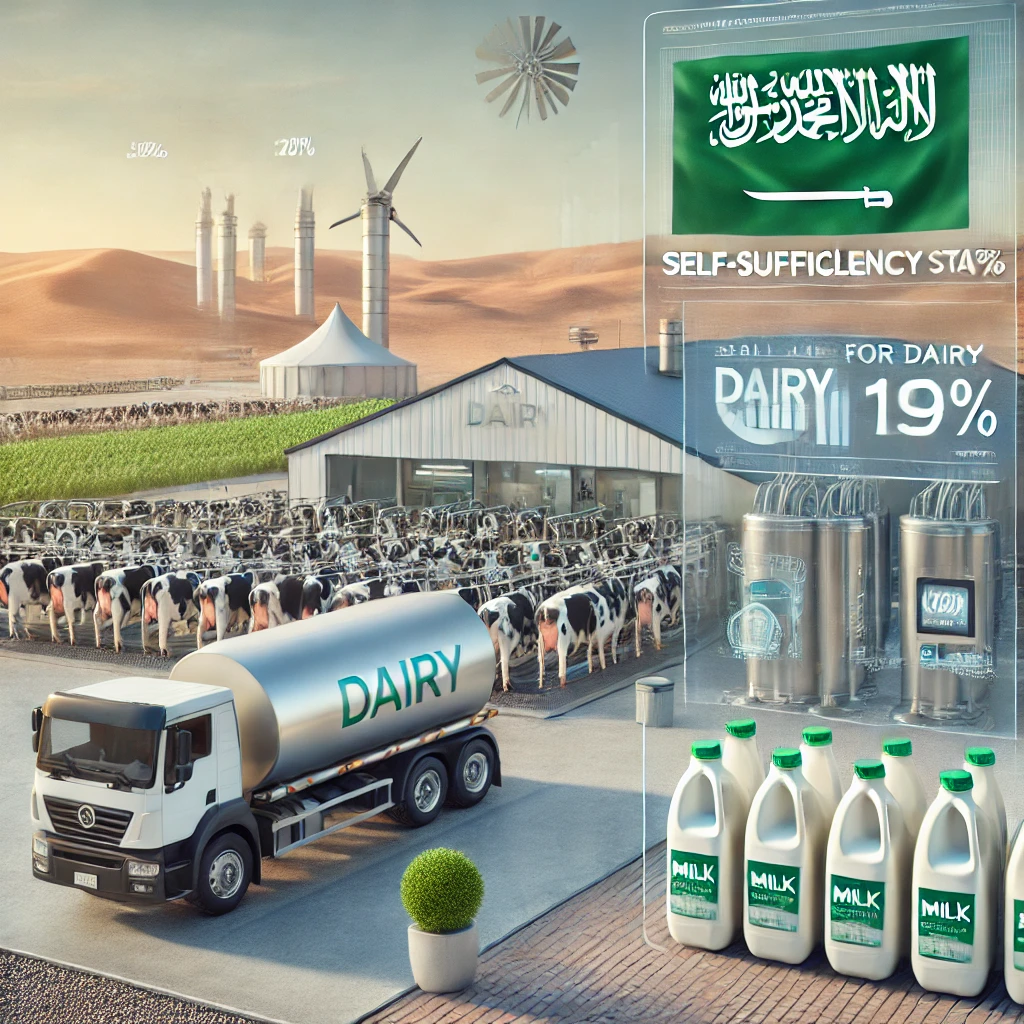By Dairy News Desk | Dairy Dimension Magazine
Based on insights from Haitham AbuGhazaleh, Strategic Account Manager, Agri, Food & Nutrition, Growth Advisory, Frost & Sullivan, and Jad Haj Chahine, Senior Consultant, Agri, Food & Nutrition, Growth Advisory, Frost & Sullivan.
Saudi Arabia is rapidly transforming its agri-food landscape, emerging as the Gulf Cooperation Council’s (GCC) largest agricultural market with a projected gross production value of USD 15.98 billion by 2025 and USD 17.68 billion by 2029, according to Statista. With agriculture contributing 4.3% to the non-oil GDP in 2023 and employing over 350,000 people, the Kingdom is strategically investing more than USD 24 billion into its environment, water, and agriculture sectors.
This shift is not just about economic diversification—it’s a targeted push toward agricultural self-sufficiency, especially in key food categories like dairy, poultry, and dates. Under the umbrella of Vision 2030, Saudi Arabia is placing sustainability, food security, and advanced AgriTech at the center of its national development.
Rising Food Demand Fuels Market Expansion
Driven by urbanization, population growth, and shifting consumption habits, Saudi Arabia’s food retail and foodservice markets are flourishing. In 2023, food retail sales surpassed USD 51 billion (CAGR 5%), while foodservices reached USD 29 billion (CAGR 10%), according to USDA estimates.
Yet, Saudi Arabia continues to import a significant portion of its food supply. Agricultural imports are projected to reach USD 11.1 billion in 2025, with a 5% CAGR through 2029. This import reliance is being strategically challenged through robust policy initiatives and sectoral investments.
Self-Sufficiency Milestones: Dairy Leads the Way
The Kingdom has made remarkable progress in achieving high levels of self-sufficiency in select agricultural sectors, especially dairy:
- Dairy Products: 129% self-sufficiency in 2024, with ambitions to reach 150% by 2030.
- Table Eggs: Fully self-sufficient (100%), aiming for 150%.
- Dates: 119% self-sufficiency.
- Poultry Meat: Currently at 71%, targeted to hit 100%.
- Red Meat: 61%, with a 100% goal.
- Fish: 48%, expected to reach 70%.
- Tomatoes & Onions: Targeting 100% and 80% self-sufficiency, respectively.
“Saudi Arabia’s success in dairy self-sufficiency—exceeding domestic demand—is a regional model. Investments in nutrition security, climate-smart agriculture, and tech-driven dairy management are paying off,” said a spokesperson from Frost & Sullivan’s Agri-Food advisory.
Dairy Dominance: Saudi Arabia’s Industry Leaders & Import Dynamics
While Saudi Arabia has achieved 129% self-sufficiency in dairy, this success is underpinned by a strong ecosystem of private and public sector collaboration, with several leading companies shaping the industry:
- Almarai: One of the largest vertically integrated dairy companies in the world, Almarai leads the Kingdom’s dairy production. With robust supply chain infrastructure and modern processing facilities, Almarai plays a pivotal role in ensuring year-round domestic dairy availability and export growth across the GCC.
- NADEC (National Agricultural Development Company): A semi-government entity, NADEC is instrumental in both fresh milk and dairy product supply. It is also known for its sustainability initiatives in water use and forage sourcing.
- Al Safi Danone: A joint venture with global dairy giant Danone, this company brings international expertise in product innovation and food safety, further strengthening the Kingdom’s dairy capabilities.
Despite high local output, Saudi Arabia still imports specific high-value dairy products and raw materials, particularly from Europe and Oceania, including:
- Infant formulas and specialized milk powders
- Premium cheeses and butter varieties
- Starter cultures and dairy enzymes used in processing
- Raw materials for dairy desserts and value-added products
Climate Realities and the Agri-Tech Response
With just 1.5% of arable land and agriculture consuming 80% of national water resources, water scarcity remains a key challenge. The Kingdom is ranked 8th globally in terms of water scarcity. However, reliance on non-renewable groundwater has sharply declined—from 19 million m³ in 2015 to 10 million m³ in 2022 (MEWA).
To mitigate these limitations, agriculture technology (AgriTech) is being fast-tracked:
- Smart Irrigation: Including drip and precision irrigation systems.
- Controlled Environment Agriculture (CEA): Greenhouses, hydroponics, vertical farming.
- Sustainable Aquaculture: Targeting 0.5 MMT production by 2030.
- Food Waste Innovation: Edible coatings, composting, anaerobic digestion.
- Drones & Satellite Imaging: For real-time crop and soil health monitoring.
Strategic Investments Powering Transformation
Key government-led initiatives are accelerating the agricultural transition:
- USD 9.8 Billion in Private Investment secured by the Ministry of Environment, Water, and Agriculture (MEWA).
- Saudi Agri-Food Tech Alliance: Supporting public-private innovation in agricultural technologies.
- SALIC’s USD 1.78 Billion Acquisition of Olam Agri: Ensuring stable access to global grain supply.
- Agricultural Development Fund (ADF): Offering low-interest loans and capital support for local farmers and AgriTech startups.
Saudi Arabia’s Agricultural Future: Resilient and Regionally Influential
Backed by Vision 2030, Saudi Arabia’s agriculture sector is evolving into a regional powerhouse. With targeted investments, regulatory reforms, and AgriTech integration, the Kingdom is not only reducing its import dependency but also positioning itself as a net exporter of key food products—particularly in dairy and dates.
The commitment to plant 14 million trees and restore 1.6 million hectares under the Saudi Green Initiative further underscores the nation’s alignment with climate-resilient agricultural practices.
